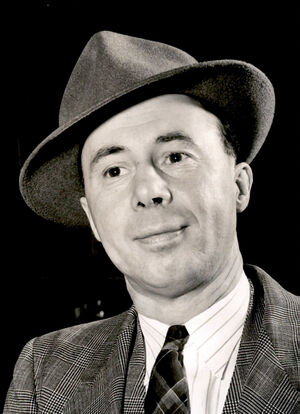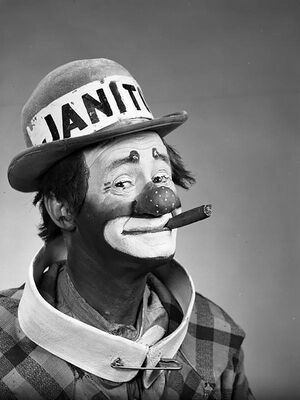Paul Jerome
From Circopedia
Clown
By Dominique Jando
Paul Jerome (1889-1960), who spent his clown career with the Ringling organization, is remembered mostly for his "Janitor" character—a "tramp" in the style of his colleagues on The Greatest Show On Earth, Emmett Kelly, Otto Griebling, and Mark Anthony—but he had begun there as a successful "whiteface" clownGeneric term for all clowns and augustes. '''Specific:''' In Europe, the elegant, whiteface character who plays the role of the straight man to the Auguste in a clown team., with a makeup and a costume close to those of Felix Adler (but without the latter's famous plumpness), a character he revived regularly, even after having created his tramp character. Paul Jerome's colleague, the clown Jack LeClaire (1890-1971), told his son Jackie LeClaire that Jerome was at that time the funniest clown on the lot.
Paul Jerome James was born on September 30, 1889, in New York, New York, according to his military records, to Paul Jerome James senior and his wife Lula, née Ragsdale, of St. Joseph, Missouri. Unfortunately, still very little is known of Paul Jerome's family background at the time of this writing: We don't know if his parents were, or not, in show business, and it seems that he had no siblings (his funeral arrangement papers mention that he had "no relatives"). Neither do we know what he did before WWI. Jerome never wrote his memoirs, and although his likeness often appeared in advertisings and in souvenirs such as porcelain statuettes and plate illustrations, he didn't seek the spotlight.
In May 1917, soon after the United States had entered World War I, Paul Jerome was drafted in the U.S. Navy, where he served as an able seaman. The war ended on November 11, 1918, and in December, after one year and seven months of service, Paul Jerome was officially discharged. He then went to work as a burlesque comedian. American burlesque was then a popular form of variety show appealing principally to male audiences and built around a chorus line of sexy female dancers, strip-tease performers, and low-brow comedians. The latter used a rich, time-honored repertoire (which they shared in part with European clown teams), and a few of them even reached stardom and converted silent and talking movies, or early television. Burlesque was indeed, like American vaudeville (variety), a very good school for comedians.
Joining Clown Alley
Whether Jerome didn't have enough success to make a decent living in burlesque, or he didn't like its atmosphere, which could be seedy in some places, he eventually decided to convert to circus life and become a clownGeneric term for all clowns and augustes. '''Specific:''' In Europe, the elegant, whiteface character who plays the role of the straight man to the Auguste in a clown team.. Circus was still one of the most popular forms of entertainment in America then (albeit on the wane) and provided good performers with regular employment in a friendly environment. In 1933, Paul Jerome (who had dropped his family name, James) joined the Clown Alley of Hagenbeck-Wallace Circus, which belonged to the Ringling organization. There, he formed a life-long friendship with another member of Clown Alley, Emmett Kelly. Then, in 1933, he was transferred to Ringling Bros. and Barnum & Bailey, where he spent practically all the rest of his clown career.Around 1937, Paul Jerome created his new "tramp" or "hobo" character. He was then nicknamed the "neon clownGeneric term for all clowns and augustes. '''Specific:''' In Europe, the elegant, whiteface character who plays the role of the straight man to the Auguste in a clown team." for the neon heart on his costume that lit up each time he saw a pretty girl—as well as for the small light bulb that was at the tip of his nose. (As a whiteface clownGeneric term for all clowns and augustes. '''Specific:''' In Europe, the elegant, whiteface character who plays the role of the straight man to the Auguste in a clown team., Jerome used sometimes a similar neon contraption in the form of glasses, and his dog also wore a glowing light at the tip of his tail.) However, Jerome is not remembered as a "production clownGeneric term for all clowns and augustes. '''Specific:''' In Europe, the elegant, whiteface character who plays the role of the straight man to the Auguste in a clown team." (the clowns who create new gags or routines for their colleagues), or as having an exceptional talent, but he was popular and recognizable enough to appear on magazine ads and in various pieces of merchandising.
During his time with Ringling, Paul Jerome often went back and forth between his whiteface and his tramp characters; unlike Otto Griebling and Emmett Kelly whose characters, which were strong and well defined, stayed unchanged, it seems that Paul Jerome's tramp character was a little too superficial to leave a truly strong mark. Nonetheless, he remained a well-liked fixture of The Greatest Show on Earth until his retirement after a last performance on the season's opening engagement at New York's Madison Square Garden in April 1957. He was sixty-eight.
Epilogue
Jerome retired in Sarasota, Florida, home to Ringling (and other circuses) performers since John and Charles Ringling chose the city for the winter quarters of their circus and participated actively in developing the town. On November 15, 1951, at age sixty-two, he had married Rose Bridgett Defliese; for an old bachelor, it was perhaps too late to make it work and they divorced four years later. Paul Jerome passed away on November 7, 1960, in Sarasota. He was seventy-one years old. As a Navy veteran, he was buried two weeks later with military honors at Arlington National Cemetery in Virginia (Grave 4675 Section 12); sadly, only three persons attended the ceremony—all members of the Circus Fans Association of America—and the only flowers were a wrath of roses sent by Emmett Kelly.















